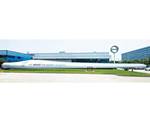Covestro delivers first order of polyurethane resin for wind blades
Covestro’s polyurethane infusion resin was developed to help the wind power industry meet the growing demand for longer wind blade designs.

Source | Covestro
Covestro (Leverkusen, Germany) has delivered its first commercial order of polyurethane raw materials for wind blades to China. The blades, produced by Zhuzhou Times New Material Technology (TMT; Hunan, China), one of the largest manufacturers of wind blades in China, have been delivered to Envision (Shanghai, China), a global wind turbine technology company. They are scheduled to be installed in a wind farm in East China next month.
Covestro delivered polyurethane resin to TMT for the production of 18 polyurethane wind blades of 59.5 meters in length, as well as for the spar caps and shear webs. To ensure successful deployment, the Covestro wind power team produced a prototype of the wind blades which has passed static and fatigue tests. The prototype was put into trial operation at a wind farm in central China in 2018.
“As an innovative material, polyurethane, compared to epoxy resin, has advantages in costs and in the production process,” says Zilu Liang, deputy chief engineer for wind power products at TMT.
Covestro’s polyurethane infusion resin was developed to help the wind power industry meet the growing demand for longer wind blade designs. Wind turbine rotor blades are typically made out of fiberglass-reinforced resin by applying vacuum infusion technology. According to Covestro, the successful use of polyurethane resin for manufacturing large-scale rotor blades for wind turbines suggests that the material itself features superior mechanical properties and anti-fatigue performance, as well as production benefits such as faster curing processing properties.
“We have cooperated with Covestro since 2016, and now we have achieved continuous production,” Liang adds. “We hope to further collaborate with Covestro to explore large-scale wind blades and wind blades completely made of polyurethane.”
“This is the first step to realizing the industrialization of polyurethane resin in the wind industry, opening up a new chapter in polyurethane chemistry,” says Irene Li, head of PU application development Asia Pacific at Covestro. “We believe that our polyurethane solution delivers significant advantages in wind blade production and along the value chain.”
Read more about polyurethane for wind blades in “Polyurethane’s processing speed, properties enable bigger blades.”
Related Content
-
MingYang reveals 18-MW offshore wind turbine model with 140-meter-long blades
The Chinese wind turbine manufacturer surpasses its 16-MW platform, optimizes wind farm construction costs for 1-GW wind farms.
-
RTM, dry braided fabric enable faster, cost-effective manufacture for hydrokinetic turbine components
Switching from prepreg to RTM led to significant time and cost savings for the manufacture of fiberglass struts and complex carbon fiber composite foils that power ORPC’s RivGen systems.
-
Composites end markets: Batteries and fuel cells (2024)
As the number of battery and fuel cell electric vehicles (EVs) grows, so do the opportunities for composites in battery enclosures and components for fuel cells.

.jpg;width=70;height=70;mode=crop)














